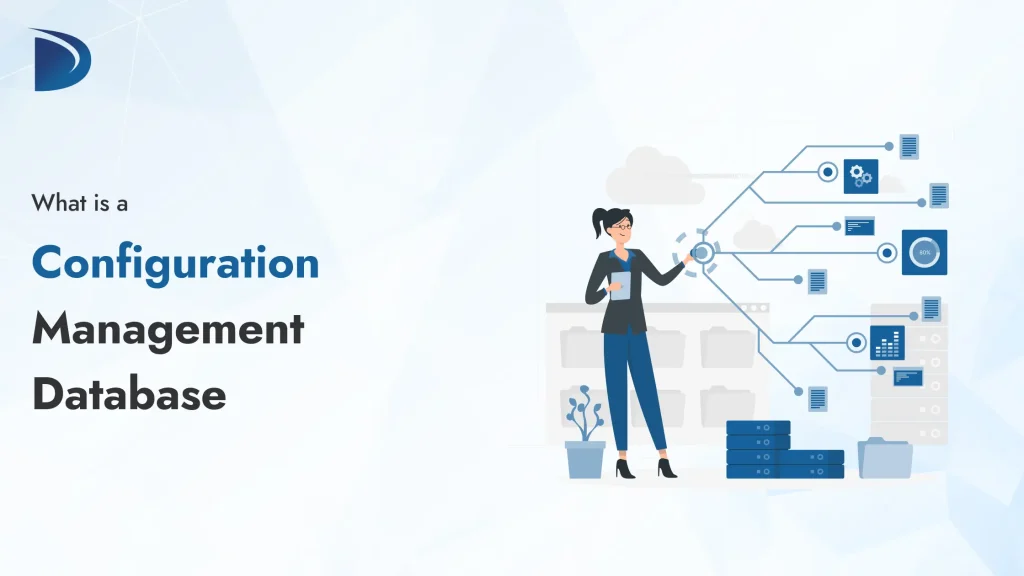Table of Contents
A Configuration Management Database (CMDB) is a centralized system that stores and manages information about the components, or “configuration items,” of an IT environment. Think of it like a detailed inventory that keeps track of hardware, software, networks, and their relationships to help organizations manage their IT systems effectively. This guide explains what a CMDB is, why it’s important, and how it works, using easy English and a clear structure.
What is a Configuration Management Database (CMDB)?
A CMDB is a database that holds information about all the critical parts of an IT system, known as configuration items (CIs). These items can include servers, computers, software applications, network devices, and even documentation. The CMDB also tracks how these items are connected and depend on each other.
- Purpose: To provide a single source of truth for IT assets and their relationships, making it easier to manage and troubleshoot systems.
- Example: A CMDB might show that a specific web server runs a customer database application and is connected to a particular network switch.
Unlike a regular inventory list, a CMDB is dynamic it’s regularly updated and includes details about how CIs interact, helping teams understand the full IT environment.
Key Components of a CMDB
A CMDB contains two main types of information:
- Configuration Items (CIs):
- These are the individual components tracked in the CMDB, such as:
- Hardware: Servers, laptops, routers, or storage devices.
- Software: Applications, operating systems, or patches.
- Network: Switches, firewalls, or IP addresses.
- Documentation: User manuals, policies, or service agreements.
- Each CI has attributes like name, version, location, or owner.
- These are the individual components tracked in the CMDB, such as:
- Relationships:
- The CMDB shows how CIs are linked. For example:
- A server hosts a specific application.
- An application depends on a database.
- A network switch connects multiple servers.
- These relationships help teams see the big picture and understand the impact of changes.
- The CMDB shows how CIs are linked. For example:
Why is a CMDB Important?
A CMDB is a vital tool for IT teams and organizations. Here’s why it matters:
- Centralized Information: Keeps all IT asset details in one place, reducing confusion and errors.
- With Decision-Making: CMDB, teams can understand how changes to one CI, such as updating software, might affect others. This not only enhances their decision-making but also instills a sense of control and confidence in managing the IT environment effectively.
- Amakes CMDB Solving: Makes it easier to find and fix issues, such as identifying which server is causing an application to crash. This efficiency in problem-solving can make IT teams feel more productive and effective in their roles.
- Improved Change Management: Ensures changes (like upgrading a network) are planned carefully to avoid disruptions.
- ACMDB Compliance: supports compliance by tracking assets and configurations to meet regulations or audit requirements. This can make IT professionals feel more secure and confident in their adherence to industry standards.
- Cost Savings: Helps avoid unnecessary purchases by showing what assets are already in use.
For example, if a website goes down, the CMDB can show which server, application, or network device is involved, helping the team fix the issue quickly.
How Does a CMDB Work?
A CMDB works by collecting, storing, and organizing data about the IT environment. Here’s a simple overview of how it functions:
- Data Collection:
- Information about CIs is gathered manually (by IT staff) or automatically (using discovery tools that scan the network).
- Example: A tool might detect a new laptop added to the network and add it to the CMDB.
- Data Storage:
- The CMDB stores CI details and relationships in a structured database.
- Example: It records that “Server A” runs “App B” and connects to “Switch C.”
- Data Updates:
- The CMDB is kept up-to-date through regular scans, manual updates, or integration with other IT tools.
- Example: If a software patch is applied, the CMDB updates the version number.
- Data Access:
- IT teams use the CMDB to view information, generate reports, or analyze the IT environment.
- Example: A manager checks the CMDB to see which servers need upgrades.
The Role of a CMDB in IT Service Management (ITSM)
A CMDB is a core part of IT Service Management (ITSM), which focuses on delivering and managing IT services. It integrates with ITSM processes like:
- Incident Management: Helps identify the cause of issues, like a server failure affecting an application.
- Change Management: Ensures changes are safe by showing how CIs are connected.
- Asset Management: Tracks the lifecycle of IT assets, from purchase to retirement.
- Problem Management: Finds the root cause of recurring issues using CI relationships.
- Service Desk: Provides support teams with details to resolve user problems faster.
For example, if a user reports that an application is slow, the service desk can use the CMDB to check which server or network device might be causing the issue.
Common Features of a CMDB
A good CMDB includes these features:
- CI Tracking: Stores details about each configuration item, like model, version, or status.
- Relationship Mapping: Shows how CIs are linked, often with visual diagrams.
- Automation: Uses discovery tools to find and update CIs automatically.
- Integration: Connects with other IT tools, like monitoring or ticketing systems.
- Reporting: Generates reports, such as a list of outdated software.
- Access Control: Limits who can view or edit the CMDB to ensure security.
Steps to Implement a CMDB
Setting up a CMDB involves a clear process to ensure it’s useful and accurate. Here’s a step-by-step guide:
1. Define Goals and Scope
Decide what the CMDB will track and why. Focus on the most critical CIs and processes.
- Example: “Track all servers, applications, and network devices to support incident management.”
- Goal: Set clear objectives for the CMDB.
2. Identify Configuration Items
Choose which CIs to include, starting with the most important ones.
- Example: Include servers, key applications, and network routers, but exclude minor items like keyboards.
- Goal: Keep the CMDB manageable and relevant.
3. Choose a CMDB Tool
Select a software platform that fits your organization’s needs and budget.
- Examples: ServiceNow, BMC Helix, or Jira Service Management.
- Goal: Pick a tool with automation, reporting, and integration features.
4. Collect and Import Data
Gather CI data using discovery tools, manual entry, or imports from existing systems.
- Example: Use a tool like SolarWinds to scan the network and add servers to the CMDB.
- Goal: Populate the CMDB with accurate data.
5. Map Relationships
Define how CIs are connected to show dependencies and impacts.
- Example: Link a web application to the server it runs on and the database it uses.
- Goal: Create a clear picture of the IT environment.
6. Integrate with IT Processes
Connect the CMDB to ITSM tools and processes, like ticketing or change management systems.
- Example: Link the CMDB to a helpdesk tool so support staff can access CI details.
- Goal: Make the CMDB useful for daily IT tasks.
7. Maintain and Update
Regularly update the CMDB to reflect changes in the IT environment, like new hardware or software upgrades.
- Tasks: Schedule scans, review data accuracy, and train staff to use the CMDB.
- Goal: Keep the CMDB current and reliable.
Popular CMDB Tools
Many tools help organizations create and manage a CMDB. Here are some common ones:
- ServiceNow: A leading ITSM platform with a powerful CMDB for tracking CIs and relationships.
- BMC Helix CMDB: Offers automation and integration for large IT environments.
- Jira Service Management: Includes a CMDB for asset and configuration tracking, which is ideal for smaller teams.
- SolarWinds Service Desk: Combines CMDB with discovery and service management features.
- Cherwell: A flexible CMDB tool for ITSM and asset management.
- iTop: An open-source option for smaller organizations.
Best Practices for a Successful CMDB
To make your CMDB effective, follow these tips:
- Start Small: Begin with critical CIs and expand gradually to avoid overwhelm.
- Keep Data Accurate: Regularly update the CMDB and verify information.
- Automate Where Possible: Use discovery tools to reduce manual work and errors.
- Train the Team: Teach staff how to use and maintain the CMDB.
- Integrate with Tools: Connect the CMDB to monitoring, ticketing, or ITSM systems for maximum value.
- Define Ownership: Assign roles to manage and update the CMDB.
- Review Regularly: Check the CMDB for outdated or incorrect data.
Challenges of a CMDB
While a CMDB is valuable, it can have challenges:
- Data Accuracy: Outdated or wrong data can make the CMDB unreliable.
- Complexity: Large IT environments with many CIs can be hard to manage.
- High Costs: Setting up and maintaining a CMDB can be expensive, especially with advanced tools.
- Resistance to Use: Staff may avoid using the CMDB if it’s not user-friendly or well-explained.
- Integration Issues: Connecting the CMDB to other tools can be tricky.
To address these, use automation, train staff, and choose a CMDB tool that fits your organization’s size and needs.
Real-World Example
Imagine a company running an online store. Their CMDB tracks:
- A web server hosts the store’s website.
- A database storing customer orders.
- A network firewall protects the system.
- The relationships, like the website, depend on the server and database.
If the website crashes, the IT team uses the CMDB to see that the server is down, check its connections, and fix the issue quickly, minimizing downtime.
Conclusion
A Configuration Management Database (CMDB) is a powerful tool for managing IT systems. By storing details about configuration items and their relationships, it helps teams understand their IT environment, solve problems faster, and make smarter decisions. Whether you’re handling incidents, planning changes, or ensuring compliance, a CMDB provides the information you need to succeed.
To create a successful CMDB, start with clear goals, choose the right tool, keep data accurate, and integrate it with your IT processes. With a well-maintained CMDB, your organization can run its IT systems smoothly and efficiently.

